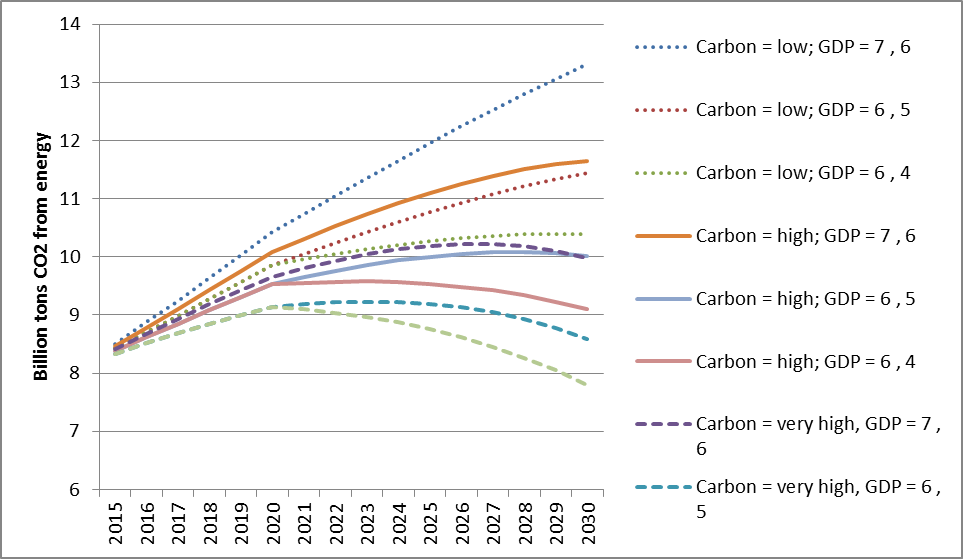La Chine a proposé aujourd'hui sa contribution pour la coopération internationale sur le changement climatique (son INDC). La Chine s'est engagée à réduire l'intensité carbone de son économie de 60-65% d'ici à 2030 par rapport à 2005, à augmenter la part des énergies non fossiles à un niveau de 20% d'ici à 2030, et à atteindre son pic d'émissions au plus tard en 2030. Ce billet analyse le contenu et les implications de cet INDC.
[chronique en anglais - traduction en français en cours]
Key messages:
- China’s contribution is serious and ambitious and should be welcomed. It implies an acceleration of the low carbon transition already underway.
- Based on current trends, it seems likely that China’s emissions will peak before 2030 and indeed probably closer to 2025 than 2030. China’s contribution is likely not the maximum that China could achieve by 2030.
- China is facing a lot of economic uncertainty, which is probably behind some of the conservatism in the Chinese contribution.
- It is important that the contribution be seen in a dynamic context, including opportunities to update and reinforce it over time.
China’s announcement is the first from a major emerging country. The fact that it chose to make this announcement during a state visit by Prime Minister Li Keqiang to Paris demonstrates to what extent China is invested in a successful conclusion to the negotiations that will end under the French Presidency in Paris at the end of the year.
Below we propose a first reading of the Chinese announcement based on four criteria.
1. Does the INDC represent an acceleration and strengthening of climate action within the country?
China has been undertaking significant actions on climate change over the past several years. Its carbon intensity has been declining at a rate of about 4.5% per year on average since 2005. This has accelerated to 5.7% since 2011.
Achieving China’s carbon intensity pledge of an improvement of 45% by 2020 compared to 2005 levels would require an improvement of about 4% per year.
Shifting to achieving a carbon intensity improvement of 65% by 2030 would require a carbon intensity improvement of about 4.4% by year between 2020 and 2030. This would include more far-reaching action to transform the energy system, as some of the low-hanging fruit of energy intensity will be exhausted.
So China’s 2030 INDC does represent an acceleration and strengthening of China’s previous pledge under the 2009 Copenhagen Accord and Cancun Agreement. However, recent changes do appear to be outpacing the speed of change that would be required to meet China’s 2020 and 2030 pledge. It seems likely that China will overachieve its 2020 target.
2. Does the INDC contain clear and credible information about how the contribution will be achieved, and the transformations it requires?
In addition, China’s multifaceted INDC raises the question of the internal coherence of its different elements. In other words, would the intensity target allow China to achieve its peak target?
In order to assess this, we construct several scenarios based on two variables: GDP growth rate and carbon intensity of GDP improvement:
- GDP growth rate:
- 7% in 2015-2020 and 6% 2021-2030
- 6% in 2015-2020 and 5% 2021-2030
- or 6% in 2015-2020 and 4% in 2021-2030
- Carbon intensity improvement against 2005 levels:
- Low carbon intensity improvement: 40% by 2020 and 60% by 2030
- High carbon intensity improvement: 45% by 2020 and 65% by 2030
- Very high carbon intensity improvement: 48% by 2020 and 70% by 2030
To give a comparison the IMF projects Chinese growth to be 6.3%/yr in 2015-2020. As noted above, China is on track to overachieve its current 2020 pledge of an improvement in carbon intensity by 40-45%.
Figure: CO2 trajectories in China for different GDP and carbon intensity scenarios

The above analysis allows the following conclusions. Taking a plausible growth scenario of 6% 2015-2020 and 5% 2021-2030, achieving the upper end of China’s intensity target would allow emissions to peak just before 2030. The peak therefore appears feasible. If, however, current trends of improvement in carbon intensity are continued, and GDP growth is at 6% in 2015-2020 and 5% in 2021-2030, then the peak would be achieved earlier, around 2025. In a high growth scenario, a continuation of current trends of carbon intensity improvement would still allow emissions to peak just before 2030.
In this sense, the fact that China did not specify the precise date or level of its peak can be considered as an ‘insurance policy’ against future growth and structural uncertainty. However, our analysis suggests that the peak is likely to be achieved before 2030, and possibly closer to 2025 than 2030.
One particular concern for China is the capacity of its statistical system. The current statistical system has been improved significantly, but still has important weaknesses. The Chinese Statistical Bureau recently advised that it had revised upwards China’s energy consumption by about 15% for the past years, amounting to about an extra 1 Gt of CO2 emissions. This should not affect the achievement of China’s 2020 and 2030 targets, but it will impact the level of the Chinese emissions peak. It does highlight the importance of continuous improvement in the capacity, transparency and precision of the Chinese statistical system.
3. How does the INDC articulate with the domestic development priorities of the country?
China's socio-economic objectives are quite coherent with a low-carbon trajectory. The key concern for China is still development. China is facing an economic slowdown: its GDP growth rates are 7.7% and 7.4% for 2013 and 2014, with 7% anticipated for 2015. Growth driven by investment is considered no longer sustainable. Facing such a situation, the central target aims at structuring its economy toward larger share of high value-added and technology-rich products with more domestic consumption-driven growth. This would entail a shift to a much more carbon efficient economic structure.
In addition, environmental pollution starting to entail increasingly social movements becomes a political issue and anti-pollution measures are and will be implemented some of which entails climate co-benefit (e.g. the reduction of coal consumption to prevent local air pollution).
China has also become the world's largest importer of crude oil, raising serious concerns about its energy security. A low-carbon transition is widely identified by Chinese policy makers as important to improve China's energy security.
4. What are the blockages and opportunities for going further?
China has a number of challenges facing it in implementing its INDC. A major one is the uncertainty of China’s future economic growth and economic structure. This is probably leading to some conservatism in China’s INDC. In the future we should be able to take stock and reassess the evolution of the Chinese economy, and its implications for its emissions trajectory. Hence the importance of a dynamic approach to policy-making, in both domestic policy and China’s international undertakings. This issue of designing a dynamic climate agreement is addressed in more detail in a recent paper together with the leading Chinese think tank NCSC.
There are many opportunities for China to strengthen the action implied by its 2030 INDC. Most analysts appear to agree that China’s INDC represents an ‘conservatively ambitious’ undertaking, and that there is potential to go further. In the light of current uncertainties, this ‘conservatively ambitious’ undertaking can perhaps be understood. China’s INDC should indeed be welcomed as a significant contribution to the fight against climate change; China really is stepping up to the plate. But it is important that both Chinese domestic policy, and international frameworks, leave space for updating this ambition over time.



